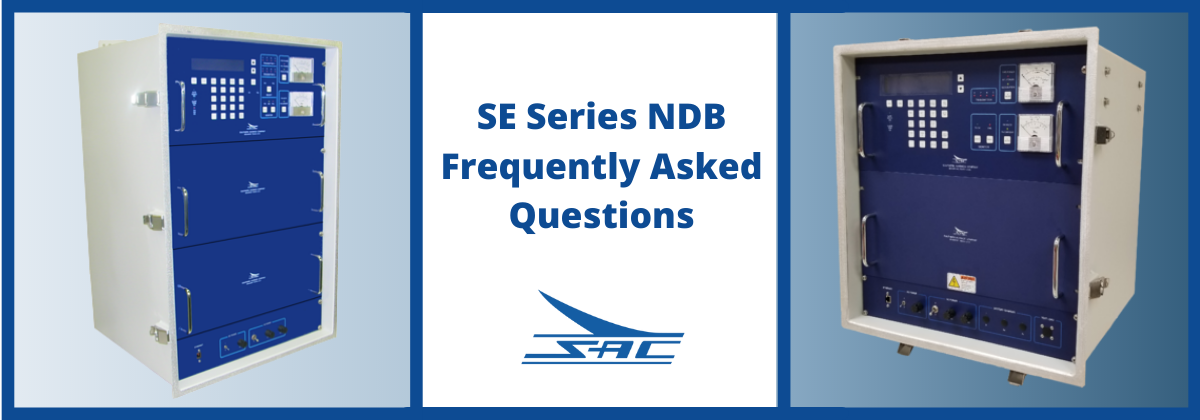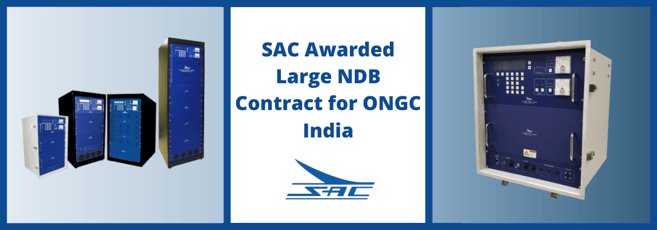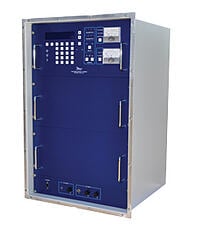Southern Avionics has successfully implemented NDB systems for clients around the globe for safe and efficient navigation to sites on land and at sea.
We are committed to building quality products and delivering the best possible customer support.
In order to help our customers, we created the following FAQ list based on our experience helping them with SE Series NDBs.
- How do I change the frequency? First, make sure your Filter module is configured for the band you are licensed to operate. The SE Series Filter module has four bands to choose from. Next, use the front panel keypad marked FREQ, then enter the desired frequency using the numbers available, and finally select the ENTER key
- How do I calibrate frequency? When the frequency of a unit is changed, the internal frequency counter needs to be recalibrated. From the front panel, press the SPCL FCTN key and then 8 - CALIBRATION. Under the Calibration menu, press 3 - FREQUENCY. Push ENTER to calibrate. After calibration, press SPCL FCTN 1 to store calibration factor. Repeat the process for TX2. To check the calibration, from the Home screen, press the down arrow. On the display, in the lower right-hand corner is FREQ:. This is the frequency that is being read. Using the keypad select SPEC FUNCT + 8 + 3. Select ENTER to perform automatic frequency calibration. Repeat for the secondary transmitter.
- How do I ensure the information I have entered is saved? Save your settings by pressing SPEC FUNCT + 1. Do this after all changes to permanent settings.
- How do I change my call sign from C6EV4 to LAPE8? Press the CALL SIGN key to open the CALL SIGN ENTRY menu. Repeat pressing the CALL SIGN key to clear the entry in the field box. Press #4 button three times for “L”, press #1 button one time for “A”, press #6 button one time for “P,” press #2 button two times for “E,” press #8 button four times for “8” and press the ENTER key when complete.
- Do I need to retune my ATU if I change the operating frequency? Yes, at the ATU the TUNE point must be verified to indicate minimum TUNE and Reflected Power. If your frequency went up, the ATU’s inductance will go down and vice-versa. See section 10 of the current manual for the full ATU tuning procedure.
- Can I connect the SE Transmitter to a Network? Yes, the SE Series transmitter is Ethernet-ready with an embedded webpage built it. If a Network is available with DHCP capabilities, simply connect your network cable to the transmitter’s internal 5-port switch. To retrieve the IP Address, select SPEC FUNCT + 9 + 2 and note the IP Address to type into any web browser of a computer connected to the same network.
- How do I connect a computer to an SE transmitter not connected to a Network? Connect an Ethernet cable between the transmitter and the computer. Select SPEC FUNCT+ 9 + 2 then + 1 to ensure DHCP is Disabled. Select SPEC FUNCT+ 9 + 2 then + 2 and type the desired IP Address. On your computer, set up a local network with a similar IP Address as your transmitter. Enter the transmitter’s IP Address into any web browser on your computer to initiate WebWatch.
- Can I operate the SE125 transmitter from +48VDC only? Yes. Turn OFF all power sources into the equipment. Move JP2, on the Battery Sense board (SLP45601) from the open position to the closed position. Now the system will operate from +48VDC only. Note the low battery DC Auto Disconnect protection will no longer work. This mode of operation is recommended for solar cell, generator, or UPS sources.
- Why is WebWatch having security issues? Because of certain security updates, you should update Internet Properties by deselecting SSL 2.0 and SSL 3.0 and selecting TLS 1.2 or higher. Once complete, select Apply followed by OK.
- Are there contacts available on the transmitter representing major and minor failure states that I can interface with my telcom monitoring system (TMS)? Both the SE transmitter and MR-5 receiver have Fail Alarm Relays. These relays only report the major FAIL state of the transmitter. The relay has an undedicated common, normally closed, and normally open contacts for easy interface into your TMS. See TB-7 on the Transmitter and TB-1 on the MR-5. The SE Transmitter also has an available option to provide SNMP interface capabilities.
- Am I able to update my SE125 Transmitter’s firmware? The current revision of the SE125 firmware is 3.04. SAC has a field change notice available for firmware upgrades from the earliest revisions to the latest. This upgrade may require significant hardware changes, if your transmitter is an earlier revision, or you may simply require the code to be upgraded. SAC does provide estimates for onsite upgrades should you need our help.
- My E8A Renesas programmer is not working on Windows 10, but it did work on Windows 7. When using Windows 10, you have to uninstall all previous versions of “Flash development Toolkit” and then install “FDT4.09r03” Only use FDT4.09r03, not FDT4.09r02. You can get it from the following link. https://www.renesas.com/us/en/products/software-tools/tools/programmer/flash-development-toolkit-programming-gui.html#downloads You will need to create an account, but it is free.
- What is the heat dissipation of the SE125 transmitter? The input power consumed at 125 Watts Carrier power with 95% modulation is 255 Watts. The average RF output power at 95% modulation is roughly 125 x 1.425 = 178 Watts to the ATU. 255 Watts – 178 Watts = 77 Watts in losses resulting in heat dissipation.
- Do the SE Series transmitters meet ICAO Annex 10 Vol. 1 Chapter 3.4 requirements? SAC maintains a controlled document for each SE Series transmitter which links Chapter 3.4 requirements to a procedural step on the transmitter’s FAT. Therefore, each time a FAT is performed, compliance is verified. Document available upon request i.e. for SE125 IP Dual, see SD0EN022.
- What is the expected Life Cycle of the SE125 transmitter? The life cycle varies depending on where the transmitter is operated i.e. Indoors or Outdoors in a high salinity environment. SAC’s estimated Life Cycle for indoor controlled conditions is 15 years, while outdoors is estimated at 10 years. More favorable outdoor conditions could extend the estimated Life Cycle.
- What is the expected Life Cycle to repair support and supply of parts for the SE125? SAC guarantees a minimum of 10 years of support for each transmitter it sells.
- I see an RESP Communication Error and the transmitter fails to retrieve IP configuration information and does not display any default values, so what can I do to fix this?
- If the Ethernet interface card has been changed for any reason, you must verify the replaced card and the Master Control board have the same firmware revisions.
- Verify the Ethernet interface card is securely mounted to the Master Control board behind the front panel.
- c. Connect the transmitter to any network with DHCP capabilities, or you can use any Router with DHCP capabilities.
- Press SPEC FUNCT + 9 + 2. You may still see the ‘Communication Error’ message.
- You will see a second screen showing “Failed to retrieve IP config from NB!”…
- The next screen is the configuration screen, and the first line should show “DHCP [DISABLED]
- Press ‘1’ until DHCP is set to Enabled or Disabled depending on your needs and press ‘Enter’.
- Press SPEC FUNCT + 1 to save these settings.
- Press SPEC FUNCT + 9 + 2. There should now be no error message.




Leave a Comment